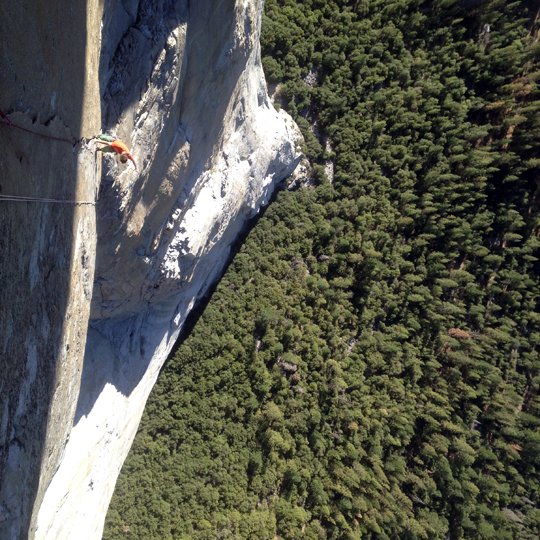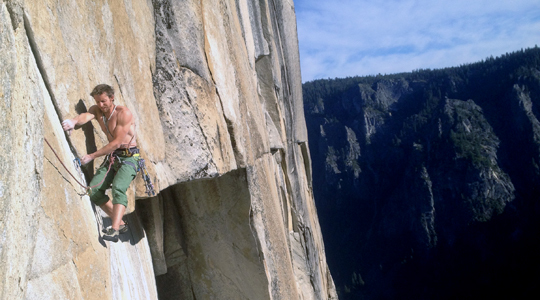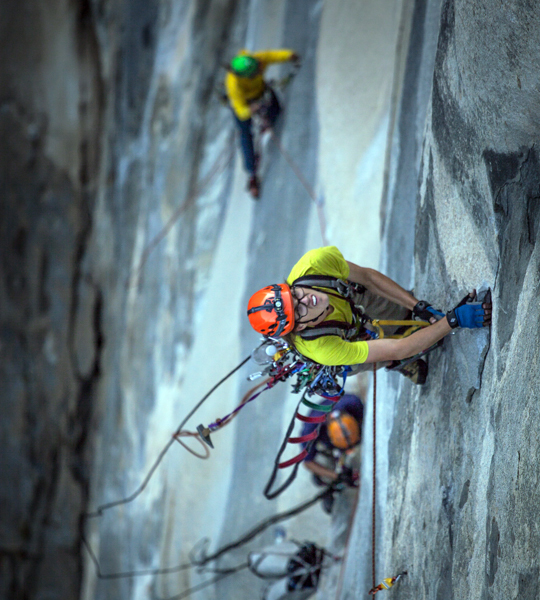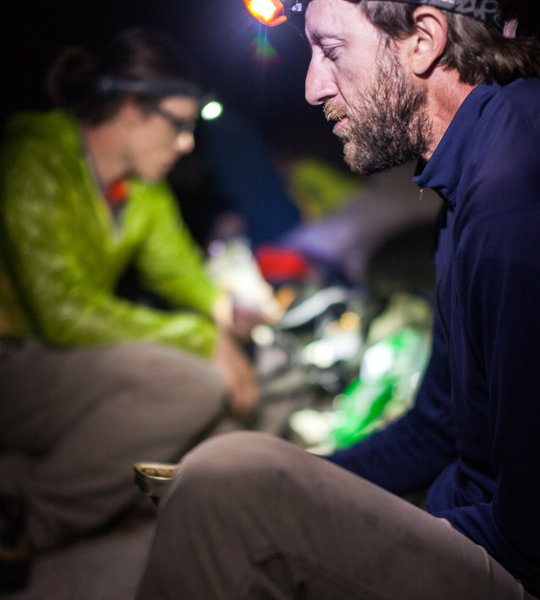
On October 3, David Allfrey, Skiy Detray and Cheyne Lempe climbed the 16-pitch A4 El Capitan test piece Zenyatta Mondatta and shaved over seven hours off the speed record. And on October 14, Alex Honnold and Tommy Caldwell climbed El Cap’s El Corazon (VI 5.13b, 35 pitches) in 15.5 hours, marking the route’s first in-a-day ascent.
I ring 29-year-old Honnold. He answers–from up on “a block on top of the second pitch of Serenity Crack.” He’s directly over the Ahwahnee Hotel, looking down valley towards El Cap. He says he’s doing some filming and taking this moment to catch up with current events on his phone as the camera is set in place. He’s unroped. “Just a typical day in the office,” he calls it.
Honnold and Caldwell had both climbed El Corazon previously. Caldwell made its second free ascent with Beth Rodden in May 2007. Honnold freed it with support from Conrad Anker in June 2009. Both climbers first did the route wall style, over about a week.
In October 2001, Alex Huber, with assistance from Max Reichel, created El Corazon by free-climbing combined pitches from the Salathe Wall, Flight of the Albatross, Son of Heart, Heart Route and variations. It was a route climbed “in typical bold Huber form,” the entry in SuperTopo: Yosemite Big Walls reads, with bolted belays but very limited fixed protection in between. He placed thin beaks, and left them in situ for future climbers.


Starting at 5:05 a.m. on October 14, Caldwell and Honnold simulclimbed up the first 10 pitches of the Freeblast start to the Salathe Wall, continuing in their simuling up from Mammoth Terraces to the first crux, Pitch 16 of El Corazon. “We wanted to reach Mammoth by light but we reached the first few pitches [of El Corazon] in the dark,” said Honnold. Still, they simulclimbed 1,500 feet of terrain in about two hours.
Then they each fell on Pitch 16, 5.13b. “Here the team had to bare down,” Honnold says. He and Caldwell avoided the notorious Beak Flake dyno via an established variation, managing to redpoint this pitch on their second go. Honnold also fell on a 5.12a move right off the Pitch 31 anchor. The Roof Traverse on Pitch 28 (5.13b) took Caldwell two attempts. Honnold remembers, “Tommy went to lead it and pumped off in the middle. He tried it the second time and the rope got stuck in a flake.” After “45 minutes of shenanigans,” they got the rope unstuck, and Caldwell repointed the pitch.
Briefly interrupting the interview, Honnold tells me the cameraman is ready. It’s time for him to continue his free solo. He hangs up, and I try to reach Caldwell, who is not available.
Instead I call up David Allfrey, who climbed El Cap seven times in seven days with Honnold earlier this summer and also made record-setting ascent of El Cap recently, on Zenyatta Mondatta (VI 5.7 A4). This quintessential hard Yosemite aid route was first climbed over seven days in March 1981 by Jim Bridwell, Peter Mayfield and Charlie Row. Back then it had five A5 pitches in a row, making it one of the hardest technical aid routes in the world.

On October 3, Allfrey, Skiy Detray and Cheyne Lempe–a trio with a combined 80 wall climbs among them–left the ground at 7:53 a.m. and topped out on Zenyatta Mondatta 16 hours, 53 minutes later. This was six hours faster than the previous fastest ascent at 22:56 by Kevin Jamarillo, Ivo Ninov and Ammon McNeely in July 2005.
As it was for Honnold and Caldwell on El Corazon, not everything for Allfrey, Detray and Lempe went as planned. On Pitch 3 Detray almost dislodged a loose block, which Lempe later trundled while following the pitch on jugs. Though they each brought a gallon of water, they still ran out in the oppressive heat.
On Pitch 12, the crux of the route protected by hooks and heads, Allfrey fell inverted for 25 feet. While pounding in a beak, the crack holding a copperhead placement he was weighting expanded, he says. “I whipped on a hook, flipped upside down, rock broke and then I fell below that onto a Totem cam. It felt like I slingshotted my back into the wall. It knocked the wind out of me.”


I ring up Detray, who, having just been bumped to first class on a flight from Atlanta, Georgia, to Paris, is on his second or third Rum and Coke. From there he’ll be heading south to Africa for 60 days of work with the military. He won’t tell me the country, but says it has no current cases of Ebola.
Detray led Zenyatta Mondatta’s first pitches, comprised of expanding rock with hooking and some rivets, in just thirty minutes. He continued his pace of 30-50 minutes per lead. Years prior, he said, “When I first led it I thought I would die,” and each pitch took about three hours. Completing his block, Detray passed the sharp end to Allfrey who climbed “cool as a cucumber,” says Detray. The call ends when Detray says the plane is taking off.

I ring Lempe who picks up from the YOSAR cache. Lempe had the night block on the climb, starting his lead as the sun faded away. “Oh man, ugh, it was hard, for sure,” he says through poor reception. “You get up at 5 a.m., hike up there, start climbing, jug, haul and belay for 10 hours. Then you have to start leading into the night as we run out of water.” He continues, “I bonked on the A3+, [Pitch 13]. It’s hard because Skiy and Dave did this incredible effort, and now I’m bonked. We knew we’d break the record but I still wanted to put in my best effort.”
After the climb, Lempe, who had photographed much of the ascent, wrote on his Facebook page, “It’s an interesting and funny balance between trying to move efficiently, survive the adventure, and capturing the story. There are so many times where getting out the camera is the last thing I want to do, but the only thing I ever regret is not shooting more.”